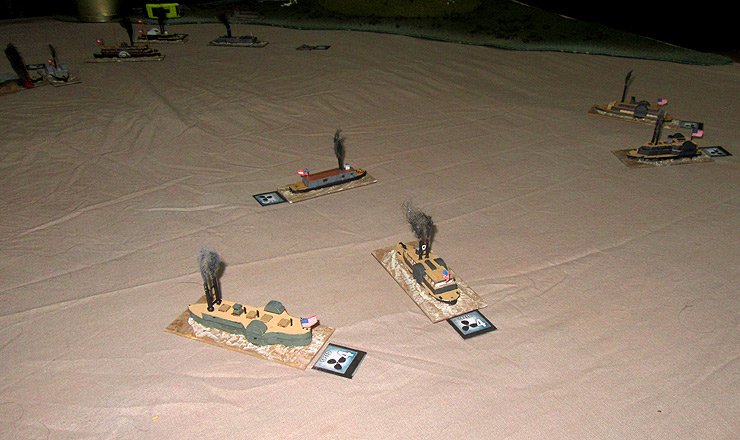
The Battle of Plum Point 1862
19th December 2024, 6 Comments
Ironclads, Dawn of Iron, 1/600 scale
For the final club game we wanted something fairly light-hearted and frivolous. This sort of fitted the bill. As you know, I’ve been trying out these rules, but this was their first proper outing, a multi-player game with lots of ships. There’s something about Mississippi paddle steamers – they look so ‘of their time’, and these ones, with very little armament and designed to ram things seemed to fit the bill perfectly. So, I give you our version of the Battle of Plum Point!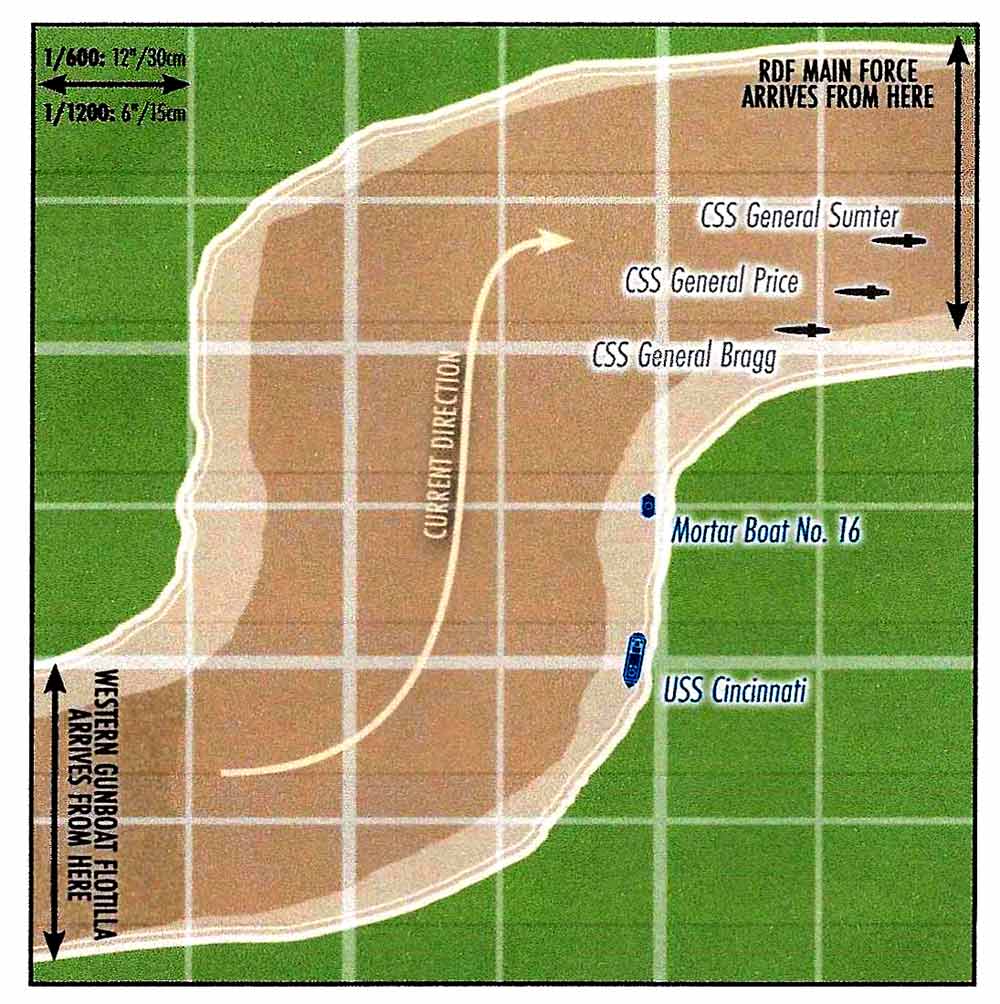 In the real scrap on the Mississippi the eight wooden rams of the River Defence Fleet were up against Union ironclads, but for the sake of evenness we swapped most of the ironclads with Union wooden paddlewheelers. Otherwise it’s the same battle. the ironclad USS Cincinnati was already on the table, without steam up, guarding a small mortar boat anchored off the western shore. The mortar boat was busy lobbing shells into a nearby enemy-held fort.
In the real scrap on the Mississippi the eight wooden rams of the River Defence Fleet were up against Union ironclads, but for the sake of evenness we swapped most of the ironclads with Union wooden paddlewheelers. Otherwise it’s the same battle. the ironclad USS Cincinnati was already on the table, without steam up, guarding a small mortar boat anchored off the western shore. The mortar boat was busy lobbing shells into a nearby enemy-held fort.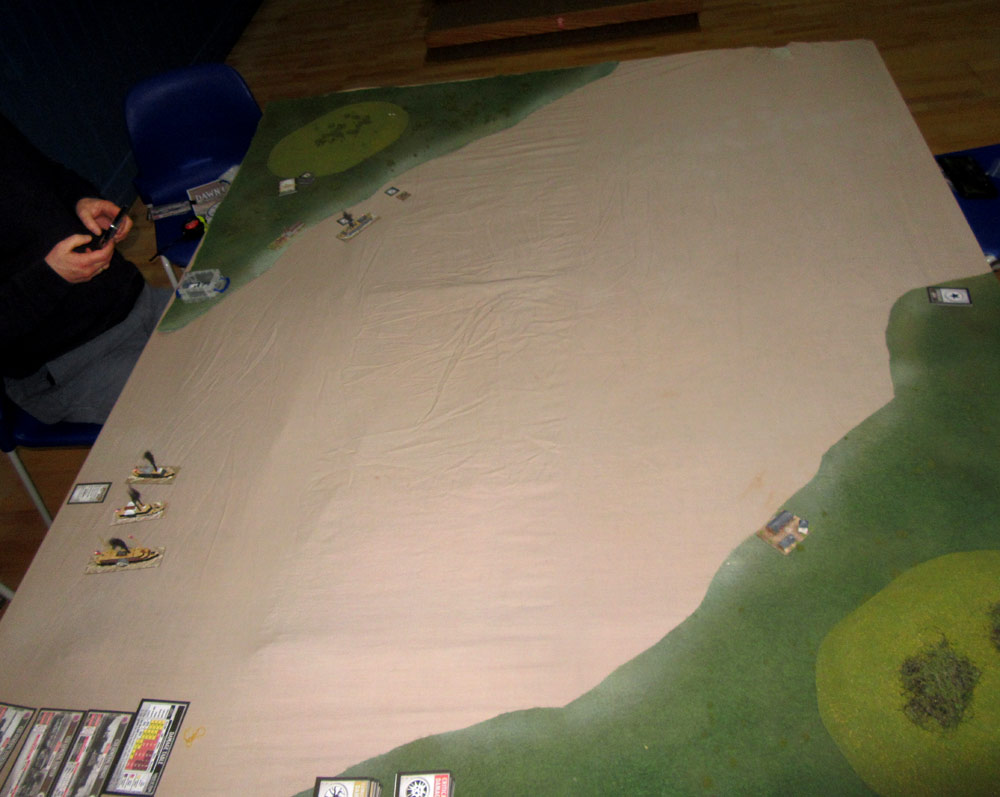 We started the game with these two Union vessels on the table, along with the first three Confederate paddlewheel rams of the River Defence Fleet; CSS General Bragg, CSS General Price and CSS General Sumter. The Confederate players (Chris and Nick) had three ships apiece, the others being the CSS General Beauregard, CSS Colonel Lovell and CSS General Beauregard. If either player lost a ship, they got another, one of two extra Confederate rams.
We started the game with these two Union vessels on the table, along with the first three Confederate paddlewheel rams of the River Defence Fleet; CSS General Bragg, CSS General Price and CSS General Sumter. The Confederate players (Chris and Nick) had three ships apiece, the others being the CSS General Beauregard, CSS Colonel Lovell and CSS General Beauregard. If either player lost a ship, they got another, one of two extra Confederate rams. 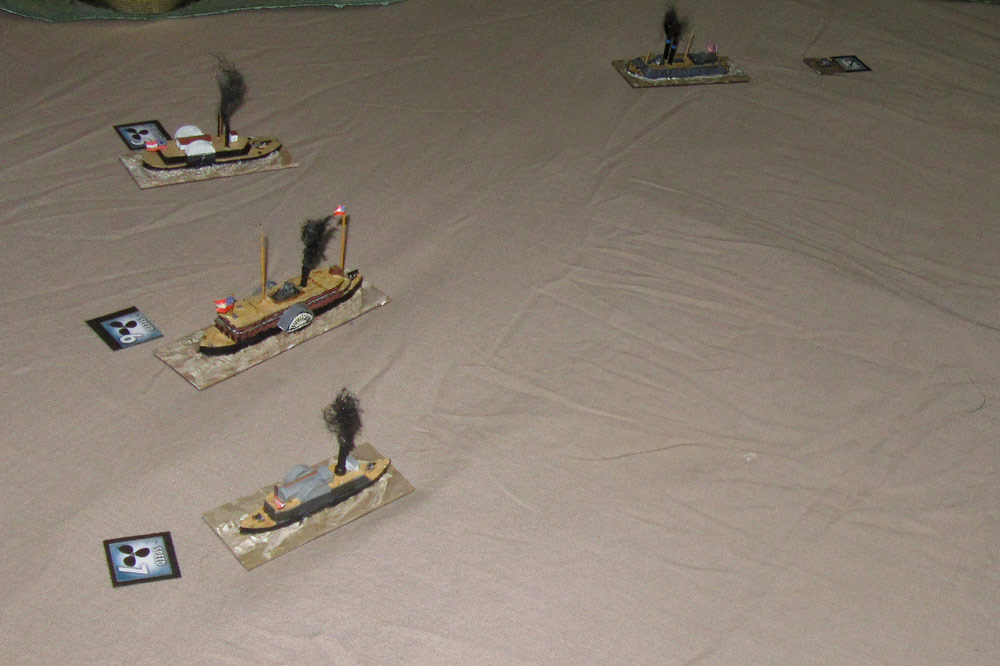 For the Union (played by Sean and I), we also had three ships apiece. Sean commanded the Cincinatti, plus the rams USS Queen of the West and USS Switzerland. I had Mortar Boat No. 16 and the rams USS Lancaster and USS Monarch. Again, we could get a new ship apiece if we lost one, but ours was chosen at random from a pool of three; the wooden gunboats USS Lexington and USS Tyler, or the ironclad USS Carondelet. The Confederates went first.
For the Union (played by Sean and I), we also had three ships apiece. Sean commanded the Cincinatti, plus the rams USS Queen of the West and USS Switzerland. I had Mortar Boat No. 16 and the rams USS Lancaster and USS Monarch. Again, we could get a new ship apiece if we lost one, but ours was chosen at random from a pool of three; the wooden gunboats USS Lexington and USS Tyler, or the ironclad USS Carondelet. The Confederates went first. Each turn a new Confederate ram came onto the table, on the southern end of the river. The same applied to us Union players, but we had to get steam up first, needing to roll a ‘5-6’ to get our boilers fired up. Needless to say, it took several turns before the first Union ships actually appeared on the table. By now though, the Union had first blood. A lucky mortar shell hit the General Sumter (above), sinking her. Still, the Confederate rams kept coming.
Each turn a new Confederate ram came onto the table, on the southern end of the river. The same applied to us Union players, but we had to get steam up first, needing to roll a ‘5-6’ to get our boilers fired up. Needless to say, it took several turns before the first Union ships actually appeared on the table. By now though, the Union had first blood. A lucky mortar shell hit the General Sumter (above), sinking her. Still, the Confederate rams kept coming.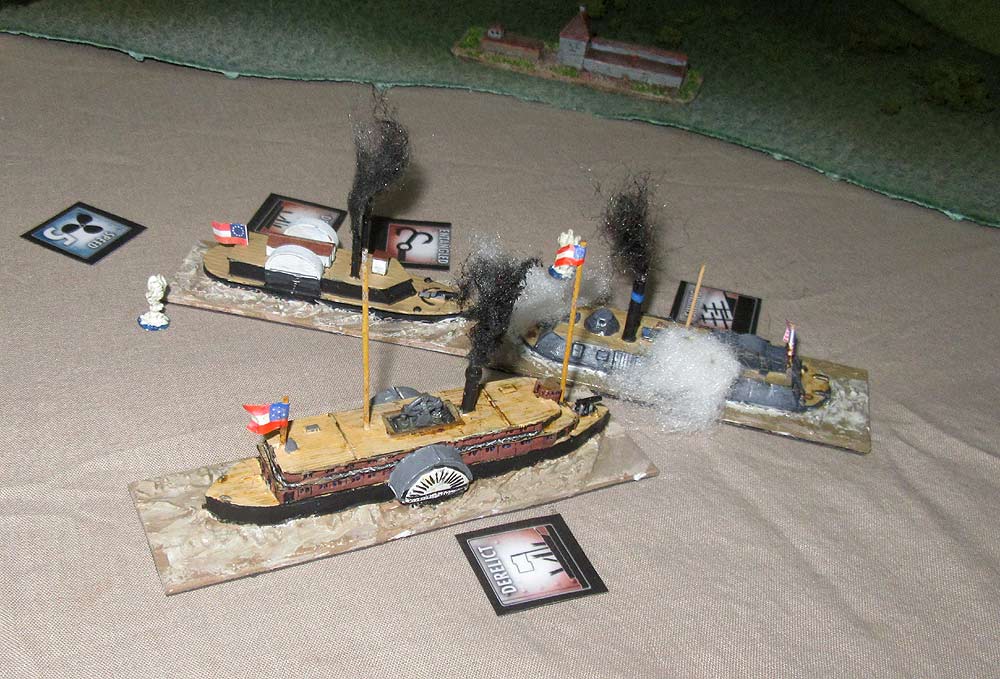 The Cincinnatti couldn’t get steam up either, but her three bow guns opened up on the approaching rams. Her first shots badly crippled the General Price, which tried a head-on ram but landed up being entangled, and her crew stunned. the General Bragg though, went in for a beam ram, which pretty much wrecked the Cincinnati, which began flooding. She sank, but both Confederate rams were too battered to move – ‘derelict’ as the game calls it.
The Cincinnatti couldn’t get steam up either, but her three bow guns opened up on the approaching rams. Her first shots badly crippled the General Price, which tried a head-on ram but landed up being entangled, and her crew stunned. the General Bragg though, went in for a beam ram, which pretty much wrecked the Cincinnati, which began flooding. She sank, but both Confederate rams were too battered to move – ‘derelict’ as the game calls it. 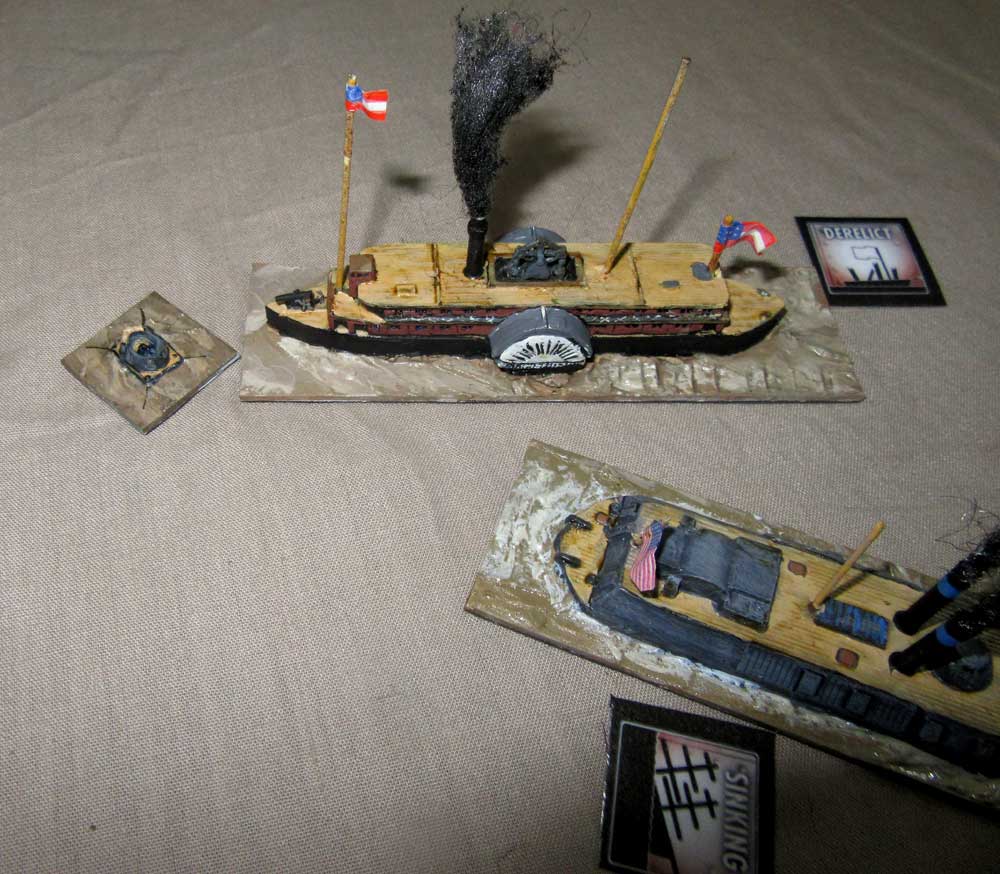 The pesky mortar boat kept firing at the Confederate rams coming onto the table, and became a target for their fire too. The mortar boat was small though, and while stationary, she was hard to hit, and protected by light armour. So, the mortar kept firing, until the freshly recovered General Bragg got moving again, and rammed Mortar Boat No. 16, which sank like a stone. Still, the General Bragg was damaged, and the crew stunned – the ship ‘derelict’.
The pesky mortar boat kept firing at the Confederate rams coming onto the table, and became a target for their fire too. The mortar boat was small though, and while stationary, she was hard to hit, and protected by light armour. So, the mortar kept firing, until the freshly recovered General Bragg got moving again, and rammed Mortar Boat No. 16, which sank like a stone. Still, the General Bragg was damaged, and the crew stunned – the ship ‘derelict’.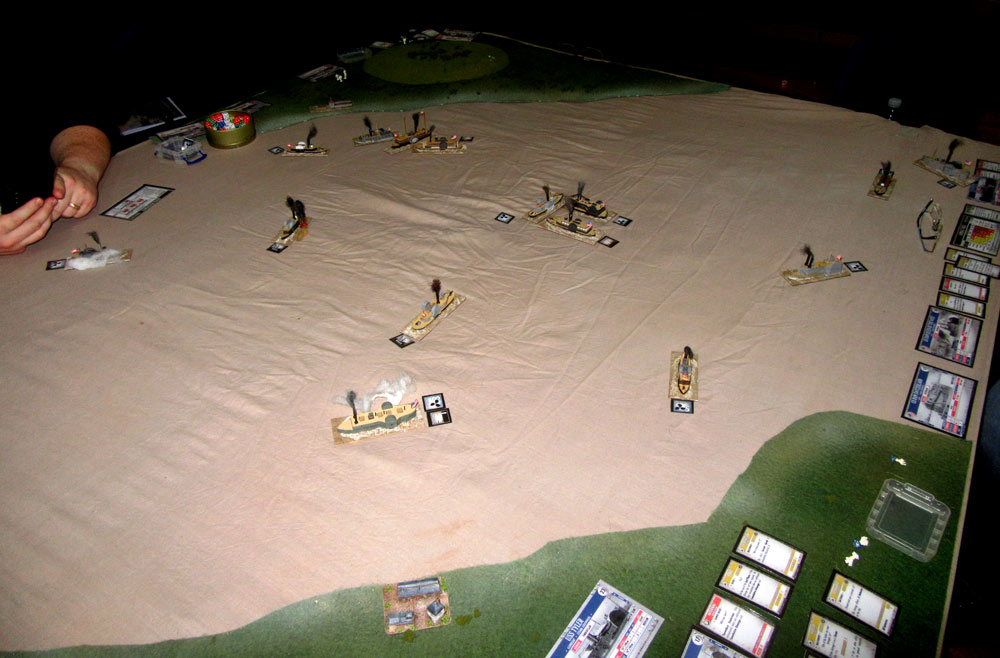 By now all four of the Union rams had appeared and with General Sumter sunk, Nick took on the fast-moving Little Rebel as a reinforcement. Sean and I also diced, but didn’t get the ironclad – instead we landed up with the wooden paddlewheel gunboats Lexington and Tyler. By now the game had turned into a real free-for-=all dogfight, with paddleboats haring around everywhere. It was just the kind of frenetic game I’d been hoping to run!
By now all four of the Union rams had appeared and with General Sumter sunk, Nick took on the fast-moving Little Rebel as a reinforcement. Sean and I also diced, but didn’t get the ironclad – instead we landed up with the wooden paddlewheel gunboats Lexington and Tyler. By now the game had turned into a real free-for-=all dogfight, with paddleboats haring around everywhere. It was just the kind of frenetic game I’d been hoping to run!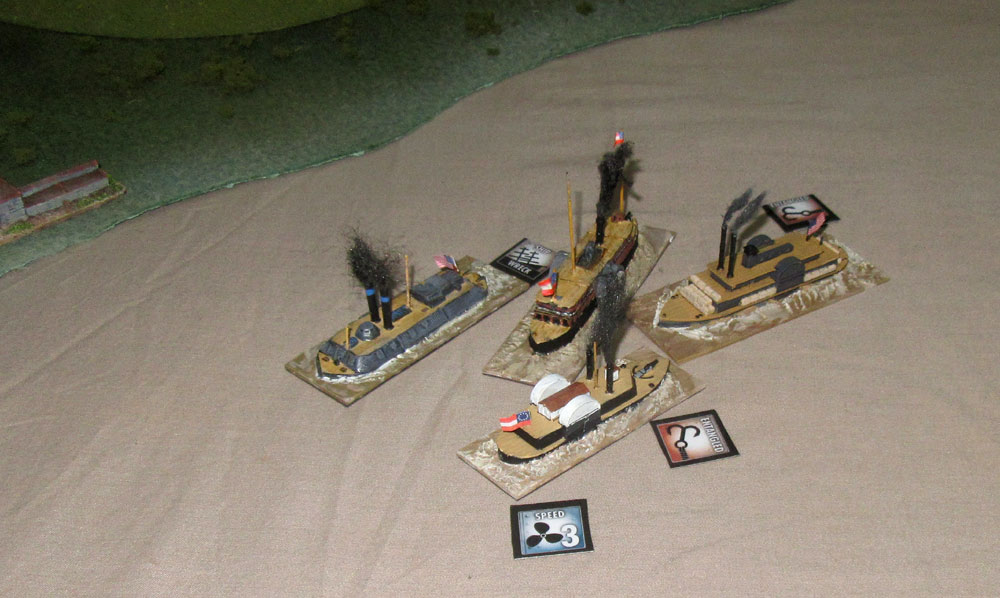 One of the Union newcomers, the wooden paddlewheel ram Monarch went up to its full speed of 5 (a 10″ move), boosted by the current (+2″), and slammed into the General Bragg, whose crew were still recovering from sinking the mortar boat. The Confederate ship sank quickly, but Monarch was just backing away when she was rammed head-on by the slow-moving General Price.Although no damage was done, the two ships became entangled. This allowed a Union boarding party to storm aboard the enemy ram, which they captured after a brief fight. this and the sinking of the General Bragg evened up the odds a bit. Still, the dogfight continued. Action now moved to the middle of the river, where the Union rams Queen of the West and Lancaster were up against the Confederate rams Little Rebel and Colonel Lovell. The first went past shooting, but the second rammed the Queen.
One of the Union newcomers, the wooden paddlewheel ram Monarch went up to its full speed of 5 (a 10″ move), boosted by the current (+2″), and slammed into the General Bragg, whose crew were still recovering from sinking the mortar boat. The Confederate ship sank quickly, but Monarch was just backing away when she was rammed head-on by the slow-moving General Price.Although no damage was done, the two ships became entangled. This allowed a Union boarding party to storm aboard the enemy ram, which they captured after a brief fight. this and the sinking of the General Bragg evened up the odds a bit. Still, the dogfight continued. Action now moved to the middle of the river, where the Union rams Queen of the West and Lancaster were up against the Confederate rams Little Rebel and Colonel Lovell. The first went past shooting, but the second rammed the Queen.  The Union ram was badly damaged, and became a ‘derelict’, which meant she should only get back into the game when her damage control teams repaired some of the damage. The Little Rebel swept past, setting her sights on another Union ships the Switzerland. Having passed Lancaster, the Little Rebel turned for a run at Switzerland, only to be raked at close range by a Union reinforcement, the Tyler, and the small Confederate ram was sunk.
The Union ram was badly damaged, and became a ‘derelict’, which meant she should only get back into the game when her damage control teams repaired some of the damage. The Little Rebel swept past, setting her sights on another Union ships the Switzerland. Having passed Lancaster, the Little Rebel turned for a run at Switzerland, only to be raked at close range by a Union reinforcement, the Tyler, and the small Confederate ram was sunk. 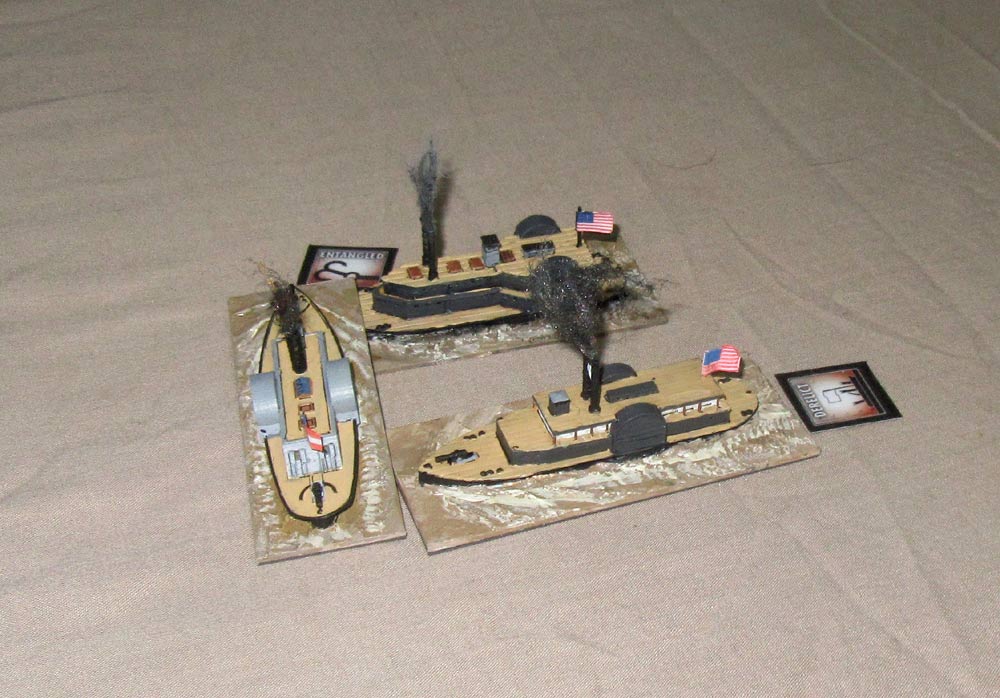 It was hard keeping up with all this, as things were going on all over the table. the second Union gunboat the Lexington was sunk by fire from the General Beauregard and the General Thomson, while the Lancaster’s crew tried and failed to board the Colonel Lovell, which was entangled with them. However, the two ships drifted apart, allowing the Colonel Lovell to move off, firing as she went. Meanwhile General Beauregard sank from unchecked flooding.
It was hard keeping up with all this, as things were going on all over the table. the second Union gunboat the Lexington was sunk by fire from the General Beauregard and the General Thomson, while the Lancaster’s crew tried and failed to board the Colonel Lovell, which was entangled with them. However, the two ships drifted apart, allowing the Colonel Lovell to move off, firing as she went. Meanwhile General Beauregard sank from unchecked flooding. 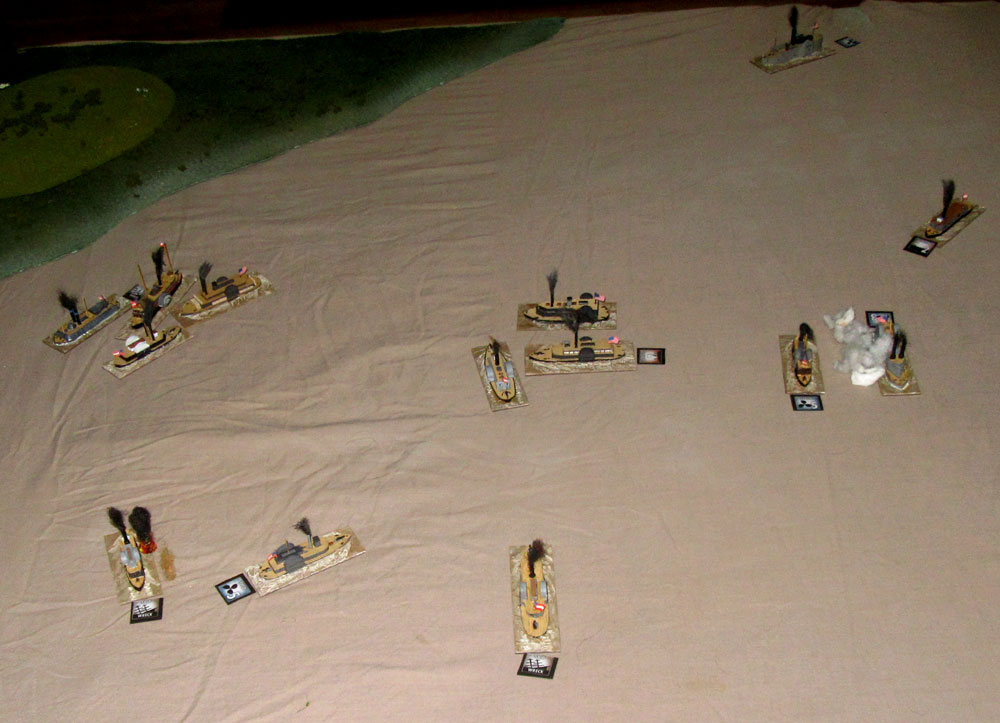 This though, was almost the time to pack up. So, we called it a day, and much as it did historically, the Confederate River Defence Force – what was left of it – pulled back downstream to lick its wounds. We did a tally of the ships sunk – five for the Confederates and three for the Union (below), with the advantage in points (the circled number in the top right) going to the Union. It was a close-run game though, and one that was memorably good fun!
This though, was almost the time to pack up. So, we called it a day, and much as it did historically, the Confederate River Defence Force – what was left of it – pulled back downstream to lick its wounds. We did a tally of the ships sunk – five for the Confederates and three for the Union (below), with the advantage in points (the circled number in the top right) going to the Union. It was a close-run game though, and one that was memorably good fun! 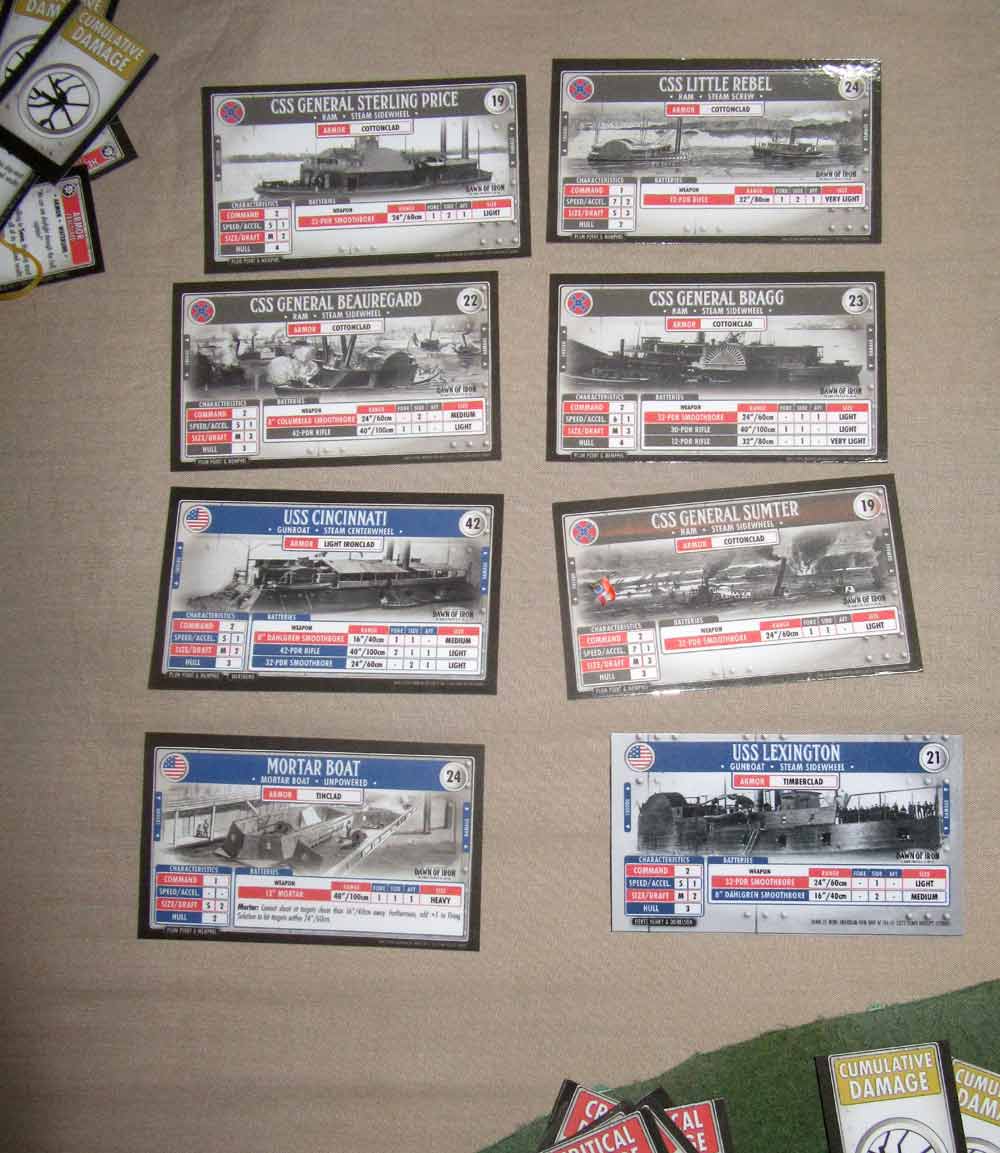
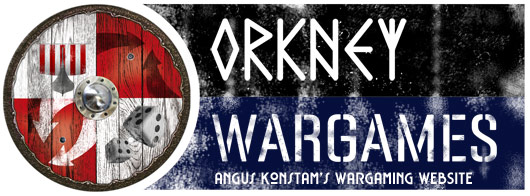
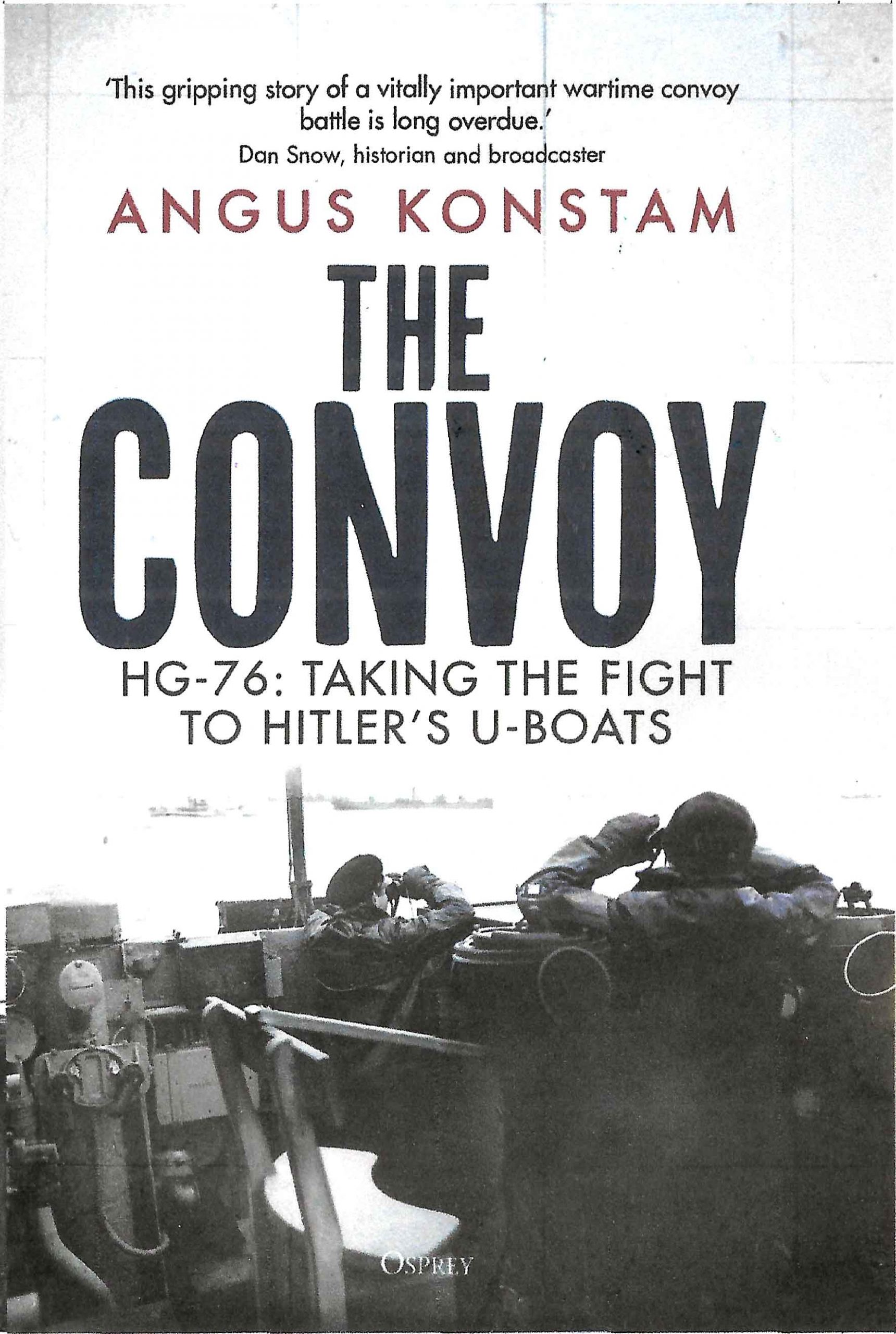
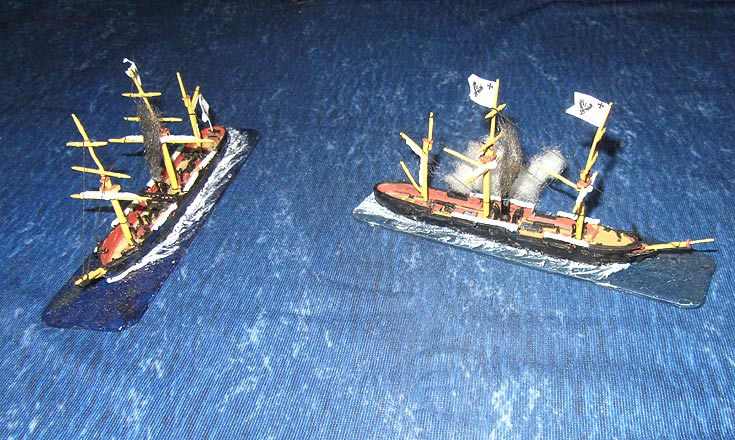
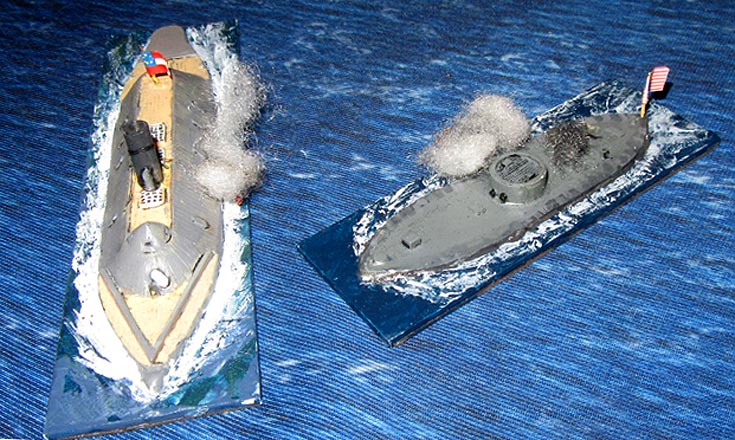
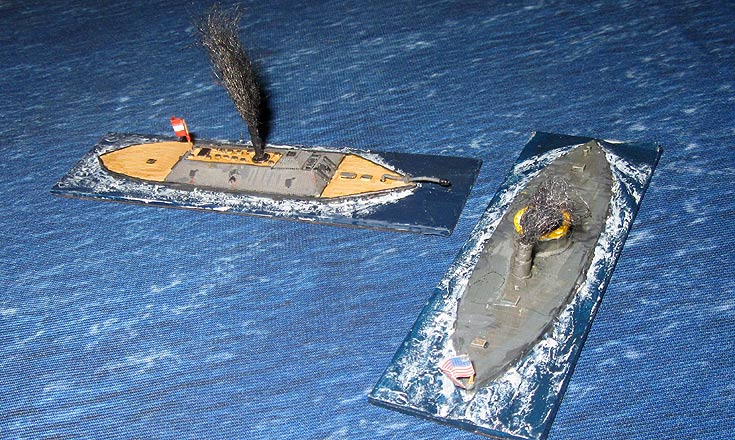
Tick VG, Angus! Like the models (brought back memories of my visit to the USS Cairo at Vicksburg earlier last year). My last game involved a Confederate river fort being attacked by a Union land force after blocking a Union river fleet’s advance up the river. Your game would have been the ideal complement to ours. All the best for 2025.
Thanks David. How did your game turn out?
Every time the river ironclads attacked a fort they seemed to get mauled. It seemed much easier attacking them from landward!
Unfortunately, the photo report is now buried somewhere in the Valour&Fortitude FB page (it was only last month, too) but some pics can be seen on the Peter Pig Forum (Eye Candy). Basically, it was deemed that the attacking Union force had broken through off-table, scattering the Rebel blocking force so the game started with a Union brigade on table and a Rebel detachment in the fort supported by a battery of field guns (the Dahlgren guns covering the river couldn’t be turned to support the land defence but the field guns could).
An additional two brigades for each side started off-table and diced for arrival on Turns 1-3, the idea being that Rebel forces were on their way to plug the gap and assist the fort’s defence with the Union brigades ‘following-up’ the off table breakthrough. Although capturing the fort was the main objective, there were also two secondary ones – a railroad station and a commanding hill in the centre of the table. Also, two of the regiments in the foremost Union regiment had 1 casualty marker, each. This was to reflect the fact that they had been in action off-table and to make the Union player decide, “do I rally these, first, or press the attack on the fort first before Rebel reinforcements arrive?”
We ran out of time, Angus, (we chat too much?) but the bottom line was that the fort was not taken before reinforcements arrived. Having been mauled attacking a defended village in a previous game, the Union player wanted to soften up the defenders before his assault this time but lots of good rally dice rolls by the Reb defenders thwarted that plan – different dice luck or a more determined assault with the bayonet throwing caution to the wind may have produced a different result. Only one secondary objective was taken but that was soon re-captured by the Rebs. The Union lost 3 regiments out of 9 and the Rebs 1 regt out of 6.
Apologies for not replying sooner (I know I had typed out quite a lengthy reply but may have been interrupted or improperly clicked ‘post comment’ – who knows?). Anyway, long story short, the fort was not taken. This was due to a certain reticence to assault by the attackers without first softening up the garrison and the defenders thwarting that plan with a series of lucky dice scores, and the Confederate reinforcements holding and/or re-taking the other objectives.
Your earlier post Dave, fell foul of me not clicking ‘Approve’ with enough force …I found it lingering in the purgatory of my ‘Pending Comments’ box. My profuse apologies, and thanks for sharing those interesting accounts!
At least I’m not as insane as I thought I was …. 😎
p.s. There’s probably a third game in that scenario; the river battle you fought, the land battle I fought and the initial, off-table land battle.